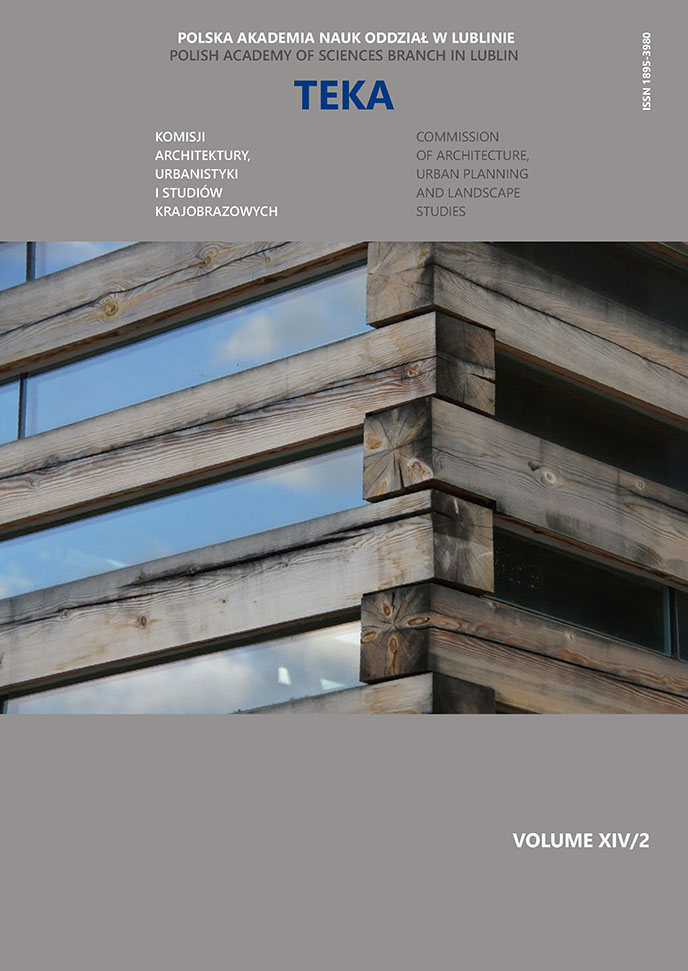Shaping space in practical therapy
Article Sidebar
Open full text
Issue Vol. 14 No. 2 (2018)
-
Town of Zhovkva (Żółkiew) in western Ukraine – an example of urban complex built at the end of the 16th century on the concept of the renaissance “ideal town”
Mykola Bevz7-20
-
Architect Max Zucker – regionalist or modernist? Designs from the Prut valley in the Hutsul region
Jacek Czubiński21-27
-
Tracking nature – the possibilities of introducing permaculture strategies into the historical city centre of Zamość. The Courtyards
Katarzyna Kielin28-37
-
Search of futuristic principles for the concept of the medical center for young people
Oleg Krasylnykov, Viktor Proskuryakov, Hayane Akopyan38-42
-
Allotment gardens in the Lublin downtown in the spatial and urban planning context – origins and issues concerning their preservation
Natalia Przesmycka, Rafał Strojny43-58
-
Shaping space in practical therapy
Piotr Gleń59-63
-
Assessment of use of public transport in cities by elderly and disabled persons
Katarzyna Solecka, Małgorzata Figura64-75
-
Stone wood and metal in the memorial sculpture of Ukrainian historical cemeteries of the Polish-Ukrainian borderlands
Olena Stasyuk76-82
-
Evaluation of the protection status of masonry crowns and proposals for their repairs – the castle in Janowiec on the Vistula
Maciej Trochonowicz, Bartosz Szostak, Daniel Lisiecki, Wojciech Królikowski83-91
-
The paradox of safety in urban space
Hubert Trammer92-96
-
Shaping of the systems of greenery in the districts of Lublin Cooperative Housing (LSM) in the context of planning and implementation of the project
Kamila Boguszewska, Natalia Przesmycka97-110
-
Location of single-family house settlements from 60s to 80s of 20th century in Wrocław’s urban space
Zuzanna Napieralska111-116
-
Eyetracking as a method to create new possibilities in urbanistic experimental research
Wojciech Kocki, Bartłomiej Kwiatkowski, Magdalena Borys, Mariusz Dzieńkowski, Wioletta Tuszyńska-Bogucka, Jacek Bogucki, Jarosław Pełka117-124
-
Recovery of urban development stages of town Rashkiv
Illia Lytvynchuk, Mykola Bevz, Bogusław Szmygin125-137
Archives
-
Vol. 16 No. 4
2020-12-30 11
-
Vol. 16 No. 3
2020-09-30 10
-
Vol. 16 No. 2
2020-06-30 11
-
Vol. 16 No. 1
2020-03-31 10
-
Vol. 15 No. 4
2019-12-30 6
-
Vol. 15 No. 3
2019-10-31 9
-
Vol. 15 No. 2
2019-06-28 12
-
Vol. 15 No. 1
2019-03-29 13
-
Vol. 14 No. 3
2018-10-28 14
-
Vol. 14 No. 2
2018-06-29 14
-
Vol. 14 No. 1
2018-03-30 13
-
Vol. 13 No. 4
2017-12-29 8
-
Vol. 13 No. 3
2017-09-29 9
-
Vol. 13 No. 2
2017-06-30 10
-
Vol. 13 No. 1
2017-03-31 10
-
Vol. 12 No. 4
2016-12-30 12
-
Vol. 12 No. 3
2016-09-30 10
-
Vol. 12 No. 2
2016-06-30 9
-
Vol. 12 No. 1
2016-03-31 8
Main Article Content
DOI
Authors
Abstract
The authors of this article present issues concerning not only disability but also rehabilitation, which allows the disabled to become more independent. The principal aim of this article is to discuss the problem of the handicapped who have to face the world that is still non-adapted to their needs in terms of architecture. Hence, this paper is focused particularly on the role of designers creating the space surrounding the disabled who strive for returning to normal active life.
Keywords:
References
The Act of 27 August 1997 on vocational and social rehabilitation and employment of disabled persons, Journal of Laws No 123, pos. 776, Chapter 1 General Provisions, Art. 1
Ibid., Chapter 2 Disability Evaluation, Art. 3;
Ibid., Chapter 3 Rehabilitation of Disabled Persons, Art. 7;
Ibid., Chapter 3 Rehabilitation of Disabled Persons, Art. 10;
ICF International classification of functioning, disability and health, World Health Organization, 2011, http://www.csioz.gov.pl/src/files/klasyfikacje/ICF_Polish_version.pdf (accessed: 10.12.2014);
Ibid., s. 3;
Regulation No. 53/2010 / DSOZ of the President of the National Health Fund of September 2, 2010 on defining conditions for the conclusion and implementation of contracts in the field of rehabilitation, http://www.nfz.gov.pl/new/index.php?katnr=3&dzialnr=12&artnr=4202 (accessed: 10.12.2014); DOI: https://doi.org/10.1016/S1359-6128(10)70514-0
Ibid.
Regulation of the Minister of Infrastructure on technical conditions that should be met by buildings and their location of April 12, 2002 (Journal of Laws No. 75, item 690)
A. Kłopotowska, Invisible architecture – the status of beauty beyond the visual perception of architectural space (in:) Czasopismo Techniczne. Architektura, edition. 6-A/2007, Kraków 2007, p. 269−274;
Progress in Medical Sciences 3/2000, Borgis publishing house, available at: czytelniamedyczna.pl http://www.czytelniamedyczna.pl/2842,rehabilitacja-medyczna-jej-cele-zalozenia-i-znaczenie-praktyczne.html# (accessed: 10.12.2014);
Celińska-Pietrzak A., Occupational therapy as an integral part of the education of disabled people (in :) C. Kosakowski, ks. C. Rogowski (edit.), Multidimensionality of education of people with disabilities, published by. University of Warmia and Mazury in Olsztyn, Olsztyn 2005, p.163.
The Act of 27 August 1997 on vocational and social rehabilitation op. cit., Chapter 3, Rehabilitation of Disabled Persons, Art. 10;
Honorary SARP Award (in:) „ARCH. Magazyn Architektoniczny SARP”, 2014, no. 6(26), p. 14−26;
Domicz A., Copyright assumptions of „M. i A. Domicz – pracownia architektury”, a text prepared for the purpose of building publication in no 7/2004 of ARCHITEKTURA – Murator monthly;
Website of the Center for Social and Professional Rehabilitation of the Foundation «Family Home Rehabilitation of Children with Cerebral Palsy» in Opole http://zaz.opole.pl/index.php?n=Pracownie (access: 10.12.2014);
Kłopotowska A., A space for learning space. The art of visually impaired and blind-friendly design (in:) Czasopismo Techniczne. Architektura , edition. 7-A2, Kraków 2010, p. 168.


